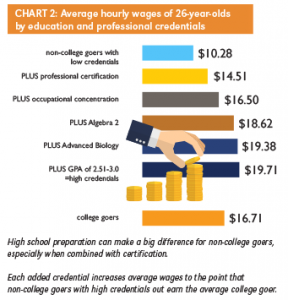More than 40 states have set statewide attainment goals for the percentage of adults holding postsecondary degrees or credentials by a certain year. These efforts have been sparked by Lumina Foundation’s 2025 national credential attainment goal – 60 percent of Americans holding a credential beyond a high school diploma by 2025.
 Some states have involved Career Technical Education (CTE) from the onset and others are now looking to ensure CTE is part of their overall strategy. The new fact sheet released by Advance CTE explains why and how CTE can be a major driver of postsecondary attainment across the country.
Some states have involved Career Technical Education (CTE) from the onset and others are now looking to ensure CTE is part of their overall strategy. The new fact sheet released by Advance CTE explains why and how CTE can be a major driver of postsecondary attainment across the country.
What States Should Do
-
Count ALL Credentials of Value towards Attainment While many learners in CTE programs do go on to earn two- and four-year degrees, many others earn industry-recognized credentials, many of which have great labor market value. States should recognize these credentials in their attainment targets.
-
Leverage Secondary CTE to Meet Statewide Attainment Goals: Increasingly, high school students taking a concentration of CTE are just as likely to go on to postsecondary education as their non-CTE peers – and are more likely to enter with workplace experiences and/or industry-recognized credentials. States should include the expansion of CTE pathways and meaningful college and career advising systems as part of their attainment strategy.
-
Support Postsecondary CTE as a Platform for Credential and Degree Attainment: Postsecondary students enrolled in CTE programs have an average attainment rate of 56.8 percent (counting credentials, certificates and degrees at two-year institutions), well above the average graduation rate for two-year institutions.
- Bring CTE to the Table as a Partner: A statewide attainment goal can and should serve as the driver of a state’s economic and workforce vision, of which CTE must be a part.
Read more about how Oklahoma, New Jersey and Tennessee have connected the dots between CTE and statewide attainment goals in the new fact sheet.
Kate Kreamer, Deputy Executive Director







 In a very spirited panel discussion, three leading experts in credentials shared some challenges and opportunities in building, validating and scaling industry-recognized credentials and certifications at NASDCTEc’s annual Spring Meeting last week.
In a very spirited panel discussion, three leading experts in credentials shared some challenges and opportunities in building, validating and scaling industry-recognized credentials and certifications at NASDCTEc’s annual Spring Meeting last week.
